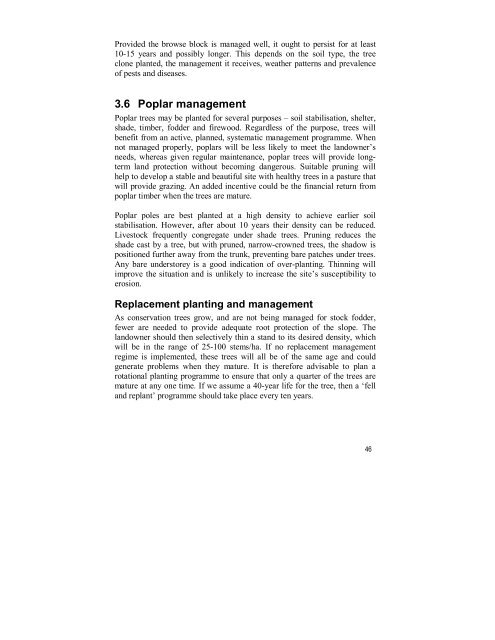Growing Poplar and Willow Trees on Farms, National - FAO
Growing Poplar and Willow Trees on Farms, National - FAO
Growing Poplar and Willow Trees on Farms, National - FAO
You also want an ePaper? Increase the reach of your titles
YUMPU automatically turns print PDFs into web optimized ePapers that Google loves.
Provided the browse block is managed well, it ought to persist for at least<br />
10-15 years <str<strong>on</strong>g>and</str<strong>on</strong>g> possibly l<strong>on</strong>ger. This depends <strong>on</strong> the soil type, the tree<br />
cl<strong>on</strong>e planted, the management it receives, weather patterns <str<strong>on</strong>g>and</str<strong>on</strong>g> prevalence<br />
of pests <str<strong>on</strong>g>and</str<strong>on</strong>g> diseases.<br />
3.6 <str<strong>on</strong>g>Poplar</str<strong>on</strong>g> management<br />
<str<strong>on</strong>g>Poplar</str<strong>on</strong>g> trees may be planted for several purposes – soil stabilisati<strong>on</strong>, shelter,<br />
shade, timber, fodder <str<strong>on</strong>g>and</str<strong>on</strong>g> firewood. Regardless of the purpose, trees will<br />
benefit from an active, planned, systematic management programme. When<br />
not managed properly, poplars will be less likely to meet the l<str<strong>on</strong>g>and</str<strong>on</strong>g>owner’s<br />
needs, whereas given regular maintenance, poplar trees will provide l<strong>on</strong>gterm<br />
l<str<strong>on</strong>g>and</str<strong>on</strong>g> protecti<strong>on</strong> without becoming dangerous. Suitable pruning will<br />
help to develop a stable <str<strong>on</strong>g>and</str<strong>on</strong>g> beautiful site with healthy trees in a pasture that<br />
will provide grazing. An added incentive could be the financial return from<br />
poplar timber when the trees are mature.<br />
<str<strong>on</strong>g>Poplar</str<strong>on</strong>g> poles are best planted at a high density to achieve earlier soil<br />
stabilisati<strong>on</strong>. However, after about 10 years their density can be reduced.<br />
Livestock frequently c<strong>on</strong>gregate under shade trees. Pruning reduces the<br />
shade cast by a tree, but with pruned, narrow-crowned trees, the shadow is<br />
positi<strong>on</strong>ed further away from the trunk, preventing bare patches under trees.<br />
Any bare understorey is a good indicati<strong>on</strong> of over-planting. Thinning will<br />
improve the situati<strong>on</strong> <str<strong>on</strong>g>and</str<strong>on</strong>g> is unlikely to increase the site’s susceptibility to<br />
erosi<strong>on</strong>.<br />
Replacement planting <str<strong>on</strong>g>and</str<strong>on</strong>g> management<br />
As c<strong>on</strong>servati<strong>on</strong> trees grow, <str<strong>on</strong>g>and</str<strong>on</strong>g> are not being managed for stock fodder,<br />
fewer are needed to provide adequate root protecti<strong>on</strong> of the slope. The<br />
l<str<strong>on</strong>g>and</str<strong>on</strong>g>owner should then selectively thin a st<str<strong>on</strong>g>and</str<strong>on</strong>g> to its desired density, which<br />
will be in the range of 25-100 stems/ha. If no replacement management<br />
regime is implemented, these trees will all be of the same age <str<strong>on</strong>g>and</str<strong>on</strong>g> could<br />
generate problems when they mature. It is therefore advisable to plan a<br />
rotati<strong>on</strong>al planting programme to ensure that <strong>on</strong>ly a quarter of the trees are<br />
mature at any <strong>on</strong>e time. If we assume a 40-year life for the tree, then a ‘fell<br />
<str<strong>on</strong>g>and</str<strong>on</strong>g> replant’ programme should take place every ten years.<br />
46

















